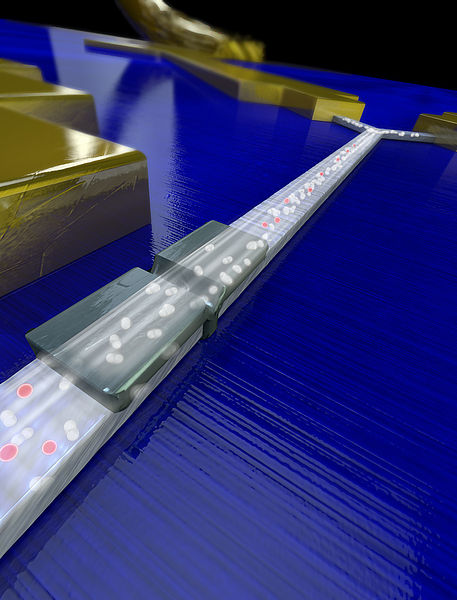25 May 2015
Discovering Majorana’s was only the first step, but utilizing it as a quantum bit (qubit) still remains a major challenge. An important step towards this goal has just been taken, as shown by researchers from TU Delft in today’s issue of Nature Physics. It is an almost thirty years old scientific problem that has just been resolved: demonstrating the difference between the even and odd occupation of a superconductor in high magnetic fields. Thus far, this was only possible in aluminium which is however incompatible with Majorana’s. This result enables the read out and manipulation of quantum states encoded in prospective Majorana qubits.
Qubit
Qubits store information similarly to normal (digital) bits. While a bit represents either 0 or 1, a qubit utilizes the laws of quantum mechanics, making it possible to be in the state of 0 and 1 at the same time. This enables solving several mathematical problems much faster than the most capable supercomputers ever built. Several research groups and companies around the globe pursue the development and prototyping of such a powerful quantum computer, including QuTech at the Delft University of Technology.
Majorana’s
A qubit encoded by Majorana’s is a promising building block for a practical quantum computer. However, until now, it was a major challenge to read out such a Majorana qubit. In order to do so, one needs to determine whether the number of the electrons is even or odd, or, in other words, what the parity state is. The measurement of the parity of superconductors has been performed for the last thirty years, however, successful experiments were exclusively done on aluminium while all attempts addressing different superconducting materials, such as vanadium or niobium, have failed. This is a major issue for Majorana research as superconductivity is required to survive up to high magnetic fields, at which aluminium ceases to be a superconductor.
An alternative of aluminium
The research group at TU Delft has succeeded in determining the parity in a different superconductor: niobium titanium nitride (NbTiN). Most importantly, this material remains superconducting at high magnetic fields, which is an essential property to create Majorana’s. “The most beautiful outcome is that not only can we distinguish between the even and odd number of electrons, but a prepared, say, even state remains the same for more than one minute” as David van Woerkom from QuTech explains. “Since we typically work with timescales of micro- or even nanoseconds, one minute is essentially an eternity”.
Quasiparticles
Majorana’s are a special kind of so-called (quasi-)particles: all measurable properties of Majorana’s are zero, meaning that this particle is its own antiparticle. A pair of Majorana’s are insensitive to local perturbations and is therefore a very promising candidate to become the building block of quantum computation. Majorana’s were first postulated in the 1930’s by the young Italian scientist Ettore Majorana, who disappeared under mysterious circumstances not more than one year after his groundbreaking work. The first experimental evidence of the Majorana particle was reported in 2012 by the group of Leo Kouwenhoven in Delft.
The Quantum Technology Institute
QuTech, founded by TU Delft and TNO is an institute developing quantum computers. The current research reported today in Nature Physics has been performed in collaboration by QuTech and Microsoft Corporation Station Q. QuTech became a ‘Nation Icon’ of the Dutch government in 2014.















